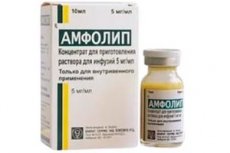安福利普
阿列克謝·克雷文科 ,醫學編輯
最近審查:04.07.2025
最近審查:04.07.2025

Ampholip(两性霉素B)是一种用于治疗真菌感染的药物,包括念珠菌病、隐球菌病、曲霉病、组织胞浆菌病、球孢子菌病等严重和危险的感染。它属于一类被称为多烯抗生素的抗真菌药物。
Ampholip 通过与真菌细胞膜的重要组成部分麦角固醇结合发挥作用。这会导致细胞膜通透性发生变化,最终导致真菌细胞死亡。
该药物通常用于治疗严重的真菌感染,尤其是免疫系统较弱的患者,例如艾滋病毒/艾滋病患者、接受化疗的患者或患有严重全身性疾病的患者。它还可用于治疗颅内结构、内脏器官的真菌感染及其他严重并发症。
適應症 安福利帕
- 念珠菌病:包括泌尿生殖系统、皮肤、粘膜、内脏和全身形式的感染。
- 隐球菌病:包括隐球菌脑膜炎及由新型隐球菌引起的其他全身性感染。
- 曲霉病:由曲霉菌引起的真菌感染,可影响肺、鼻窦、皮肤和其他器官。
- 组织胞浆菌病:包括由荚膜组织胞浆菌引起的急性和慢性感染。
- 球孢子菌病(长孢子菌病):由球孢子菌或球孢子菌引起的感染,可影响肺、皮肤和其他器官。
- 毛霉菌病:包括由毛霉菌属引起的侵袭性感染,可影响血管系统、眼睛、皮肤和其他器官。
- 芽生菌病:由皮炎芽生菌引起的感染,可影响肺部和其他器官。
- 着色芽生菌病:由着色杆菌属引起的感染,可影响皮肤、粘膜和其他器官。
- 其他真菌感染:两性霉素 B 也可用于治疗对其他抗真菌药物无反应的其他严重或全身性真菌感染。
發布表單
浓缩溶液:此形式也是一种浓缩物质,使用前必须溶于适当的溶剂中。通常用于静脉给药。
藥效學
- 与麦角固醇的相互作用:两性霉素B与麦角固醇结合,麦角固醇是真菌细胞膜的重要组成部分。这种相互作用导致膜结构和功能的改变。
- 细胞膜损伤:两性霉素B与麦角固醇结合会导致真菌细胞膜形成孔隙。这种膜损伤会导致细胞成分泄漏,破坏细胞稳态。
- 作用的选择性:由于真菌和人体细胞的细胞膜组成存在差异,两性霉素B对真菌细胞具有选择性。
- 作用谱广:该药物对多种真菌均有活性,包括念珠菌属、曲霉菌属、新型隐球菌、荚膜组织胞浆菌、球孢子菌属等。
- 耐药机制:与大多数抗生素不同,两性霉素B很少引起真菌耐药性。这是由于其独特的作用机制,即通过改变细胞膜的物理化学性质来发挥作用。
藥代動力學
- 吸收:口服时,两性霉素 B 通常很难从胃肠道吸收,并且由于生物利用度低,通常不以口服片剂形式使用。
- 分布:两性霉素B入血后,迅速分布于全身。该药物广泛分布于皮肤、肺、肾、肝、脾和脑等组织中。其分布仅限于血浆蛋白。
- 代谢:两性霉素B的代谢很小。它在肝脏中的生物转化作用极小。
- 排泄:大部分两性霉素B以原型经肾脏排泄。治疗结束后,该药物仍可能在组织中长期残留。
- 半衰期:两性霉素B在血液中的半衰期约为15天,这表明它在体内残留的时间很长。
- 肾功能不全患者的特殊注意事项:肾功能不全患者中,两性霉素B的消除时间可能会增加,需要调整剂量。
劑量和管理
- 念珠菌病:念珠菌病的常用治疗剂量为每日每公斤体重0.5至1毫克。感染严重时,剂量可增至每日每公斤体重1.5毫克。
- 隐球菌病:治疗隐球菌病,通常剂量为每日0.3-0.6毫克/千克(kg·d)。某些病例,尤其是脑膜炎,剂量可增至每日0.7-1毫克/千克(kg·d)。
- 曲霉病:常用剂量为每天0.5-0.7mg/kg。
- 组织胞浆菌病、球孢子菌病和其他感染:剂量可能因感染的类型和严重程度以及患者对治疗的反应而异。
值得注意的是,医生可能会根据治疗反应和药物毒性调整Amfolip的剂量。该药物通常在数小时内缓慢注入静脉,以尽量减少可能出现的输液反应。
在懷孕期間使用 安福利帕
- 使用益处:在某些情况下,真菌感染可能对母亲和胎儿的生命构成严重威胁。在这种情况下,使用 Amfolip 治疗严重或危险的感染是合理的。
- 对胎儿的风险:目前尚无足够数据证明安福利普在妊娠期间的安全性,因此无法对其对胎儿的安全性得出明确结论。对胎儿的潜在风险包括可能对胎儿发育中的器官和系统产生毒性作用。
- 计划怀孕:如果女性计划怀孕或在服用Ampholip期间发现自己怀孕,务必与医生讨论。医生可以审查治疗计划,并决定是否继续或停止治疗。
- 监测:如果在怀孕期间必须使用 Amfolip,则必须在医生的监督下仔细监测母亲和胎儿的状况。
禁忌
- 已知过敏:已知对 Ampholip 或该药物的任何其他成分过敏的患者不应服用该药物。
- 严重肾功能不全:使用 Amfolip 可能会使严重肾功能不全患者的病情恶化。在这种情况下,药物可能会在体内蓄积,引起毒性作用。
- 低钾血症:安菲利普可能导致低钾血症(血液中钾含量低)。易患低钾血症或已确诊患有低钾血症的患者,发生严重心血管并发症的风险可能会增加。
- 严重心力衰竭:对于患有严重心力衰竭的患者,使用 Ampholip 可能会使心脏状况恶化并导致严重的并发症。
- 怀孕和哺乳:怀孕和哺乳期间使用 Ampholip 应由医生进行评估,并根据对母亲和胎儿或婴儿的潜在益处和风险进行考虑。
- 动脉低血压患者:Ampholip 可能导致动脉低血压(低血压)。对于血压本来就低的患者,这可能会导致严重的并发症。
副作用 安福利帕
- 输液反应:Ampholip输液期间可能会出现急性反应,例如发烧、发冷、头痛、低血压、恶心、呕吐、腹泻、关节痛和肌痛。
- 电解质紊乱:Ampholip 可能引起低钾血症(低血钾)、低镁血症(低血镁)和其他电解质紊乱,从而导致心律失常和心肌功能障碍。
- 肾脏损害:长期使用 Ampholip 可能会导致肾脏损害和肾衰竭。
- 肝毒性:一些患者可能会出现肝酶升高,以及肝炎和黄疸。
- 造血功能障碍:Ampholip 可能导致贫血、白细胞减少症(白细胞计数减少)和血小板减少症(血小板计数减少)。
- 神经系统反应:可能出现头痛、头晕、周围神经病变等神经系统反应。
- 过敏反应:可能出现过敏反应,包括皮疹、瘙痒、荨麻疹和过敏性休克。
- 各种其他副作用:可能出现心律失常、高血压、缺氧、高血压危象等其他不良事件。
過量
过量服用 Ampholip 可能会增加副作用,如肾毒性、电解质紊乱(如低钾血症、低镁血症)以及危及生命的输液反应,如过敏性休克或严重心血管事件。
與其他藥物的相互作用
- 氨基糖苷类抗生素:两性霉素 B 与氨基糖苷类抗生素(如庆大霉素或阿米卡星)同时使用可能会增加肾脏损害的风险。
- 环孢菌素:Ampholip 与环孢菌素同时使用可能会导致环孢菌素的血液浓度升高和肾毒性增加。
- 地高辛:两性霉素 B 可能会影响血液中的地高辛浓度,从而导致心脏毒性增加。
- 脂质制剂:将 Ampholip 与脂质制剂(如氨茶碱或左甲状腺素)一起使用可能会因与血浆蛋白相互作用而降低其有效性。
- 卡马西平:Ampholip 可能会影响血液中的卡马西平浓度,这可能需要调整其剂量。
- 别嘌呤醇:别嘌呤醇与两性霉素 B 一起使用可能会增加罹患别嘌呤醇肾病的风险。
- 其他影响肾功能的药物:Ampholip 可能会增强影响肾功能的药物的毒性作用,例如肾毒性抗生素或非甾体抗炎药。
注意!
為了簡化對信息的理解,本指令使用了藥物 "安福利普",並根據藥物的醫療用途官方說明。 使用前請閱讀直接用於藥物的註釋。
描述僅供參考,不適用於自我修復指導。 這種藥物的需求,治療方案的目的,藥物的方法和劑量僅由主治醫師確定。 自我藥療對你的健康有危害。

